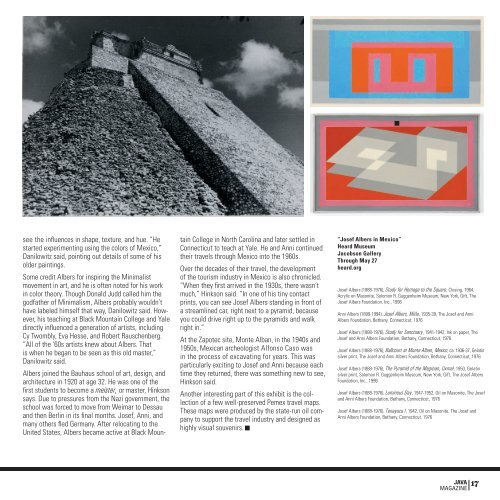JAVA Mar-2019
Create successful ePaper yourself
Turn your PDF publications into a flip-book with our unique Google optimized e-Paper software.
see the influences in shape, texture, and hue. “He<br />
started experimenting using the colors of Mexico,”<br />
Danilowitz said, pointing out details of some of his<br />
older paintings.<br />
Some credit Albers for inspiring the Minimalist<br />
movement in art, and he is often noted for his work<br />
in color theory. Though Donald Judd called him the<br />
godfather of Minimalism, Albers probably wouldn’t<br />
have labeled himself that way, Danilowitz said. However,<br />
his teaching at Black Mountain College and Yale<br />
directly influenced a generation of artists, including<br />
Cy Twombly, Eva Hesse, and Robert Rauschenberg.<br />
“All of the ’60s artists knew about Albers. That<br />
is when he began to be seen as this old master,”<br />
Danilowitz said.<br />
Albers joined the Bauhaus school of art, design, and<br />
architecture in 1920 at age 32. He was one of the<br />
first students to become a meister, or master, Hinkson<br />
says. Due to pressures from the Nazi government, the<br />
school was forced to move from Weimar to Dessau<br />
and then Berlin in its final months. Josef, Anni, and<br />
many others fled Germany. After relocating to the<br />
United States, Albers became active at Black Mountain<br />
College in North Carolina and later settled in<br />
Connecticut to teach at Yale. He and Anni continued<br />
their travels through Mexico into the 1960s.<br />
Over the decades of their travel, the development<br />
of the tourism industry in Mexico is also chronicled.<br />
“When they first arrived in the 1930s, there wasn’t<br />
much,” Hinkson said. “In one of his tiny contact<br />
prints, you can see Josef Albers standing in front of<br />
a streamlined car, right next to a pyramid, because<br />
you could drive right up to the pyramids and walk<br />
right in.”<br />
At the Zapotec site, Monte Alban, in the 1940s and<br />
1950s, Mexican archeologist Alfonso Caso was<br />
in the process of excavating for years. This was<br />
particularly exciting to Josef and Anni because each<br />
time they returned, there was something new to see,<br />
Hinkson said.<br />
Another interesting part of this exhibit is the collection<br />
of a few well-preserved Pemex travel maps.<br />
These maps were produced by the state-run oil company<br />
to support the travel industry and designed as<br />
highly visual souvenirs.<br />
“Josef Albers in Mexico”<br />
Heard Museum<br />
Jacobson Gallery<br />
Through May 27<br />
heard.org<br />
Josef Albers (1888-1976), Study for Homage to the Square, Closing, 1964,<br />
Acrylic on Masonite, Solomon R. Guggenheim Museum, New York, Gift, The<br />
Josef Albers Foundation, Inc., 1996<br />
Anni Albers (1899-1994), Josef Albers, Mitla, 1935-39, The Josef and Anni<br />
Albers Foundation, Bethany, Connecticut, 1976<br />
Josef Albers (1888-1976), Study for Sanctuary, 1941-1942, Ink on paper, The<br />
Josef and Anni Albers Foundation, Bethany, Connecticut, 1976<br />
Josef Albers (1888-1976), Ballcourt at Monte Alban, Mexico, ca. 1936-37, Gelatin<br />
silver print, The Josef and Anni Albers Foundation, Bethany, Connecticut, 1976<br />
Josef Albers (1888-1976), The Pyramid of the Magician, Uxmal, 1950, Gelatin<br />
silver print, Solomon R. Guggenheim Museum, New York, Gift, The Josef Albers<br />
Foundation, Inc., 1996<br />
Josef Albers (1888-1976), Luminous Day, 1947-1952, Oil on Masonite, The Josef<br />
and Anni Albers Foundation, Bethany, Connecticut, 1976<br />
Josef Albers (1888-1976), Tenayuca I, 1942, Oil on Masonite, The Josef and<br />
Anni Albers Foundation, Bethany, Connecticut, 1976<br />
<strong>JAVA</strong> 17<br />
MAGAZINE

















